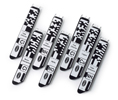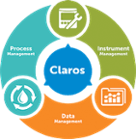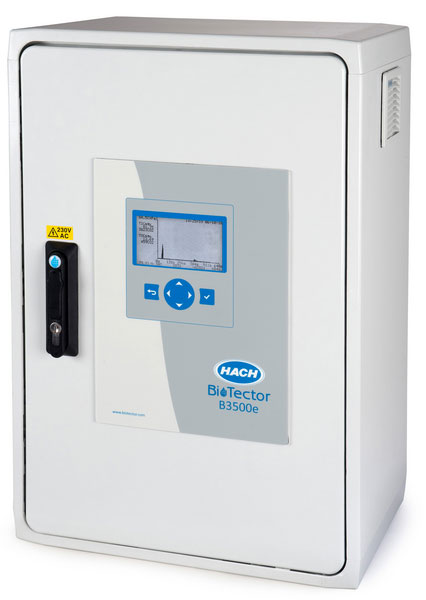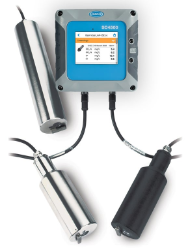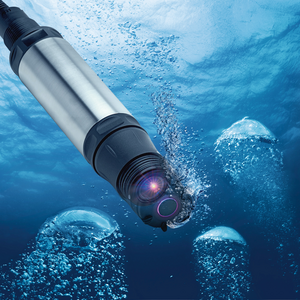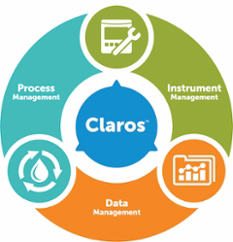-
Products
- Lab Instruments
-
Lab Meters and Probes
Calibration Standards Radiometer Probes
- Chemistries, Reagents, and Standards
-
Online Analyzers
Ammonium Analysers Ammonia Monochloramine Analyzers Chlorine Analyzers
- CL17sc
- CL10sc Amperometric
- Ultra Low Range CL17sc Colorimetric Chlorine Analyser
- RMC Disinfection Panel
- Flow and Collections
-
Online Sensors and Controllers
pH & ORP Sensors
- 12mm pH/ORP
- 8362 sc High Purity
- Combination pH/ORP
- Differential pH
- Digital Differential ORP
- Digital Differential pH
- LCP ORP
- LCP pH
Conductivity Sensors- 3400 Analogue Contacting
- 3400 Digital Contacting
- 3700 Analogue Inductive
- 3700 Digital Inductive
- 9523 Cation Conductivity
- Samplers
- Claros Water Intelligence System
- Test Kits & Strips
-
Microbiology
Accessories and Chemicals Dehydrated MediaLabware
- Accessories
- Funnels, Pumps & Manifolds
- Microbiology Filters
- Petri Dishes & Accessories
- Sampling Bags
- Vials, Tubes, Bottles & Racks
-
Lab Equipment and Supply
Apparatus
- Brushes
- Clamps, Rings & Stands
- Crucibles
- Crucibles & Casseroles
- Dispensers & Droppers
- Grab Samplers
- Oil and Grease
- Other Apparatus
- Pipet Aids
- Pipettes
- Racks
- Stir Bars
- Tubing
- Weighing Accessories
General Lab Consumables Glassware/PlasticwareInstruments Safety Equipment - Automated Lab Systems
- Industrial UV
- Parameters
- Industries
- Support
- Service
- e-Shop
- Brands
Hach New Zealand
Choose your country or region:
Europe
Americas
Asia - Australasia
- Australia
- Mainland China
- India
- Indonesia
- Japan
- Malaysia
- New Zealand
- Philippines
- Singapore
- South Korea
- Thailand (Thai)
- Taiwan
Middle East - Africa
Chemistries 0800 50 55 66
Municipal Wastewater Treatment
Wastewater Treatment Processes – Doing More With Less
Each wastewater treatment plant is unique, with its own capacity, layout, processes and equipment, and effluent limits. And each plant is faced with rising energy and chemical costs, and regulations that change or become more stringent over time.
We embrace the challenge to continuously improve wastewater monitoring equipment and processes including:
- Nutrient monitoring
- Aeration control
- Nitrification/denitrification
- Sludge dewatering
- Solids handling
- Biological wastewater treatment
- Other plant operations and optimization
Whether in primary, secondary or tertiary wastewater treatment or the promise of a Water Intelligence System, Hach® innovations and applications can help you stay in compliance and reduce operating costs, doing more with less.
Get the confidence that your plant is running smoothly with Hach.

Explore Featured Products
Reliable, continuous environmental monitoring and real-time process control, Hach BioTector TOC analyzers allow wastewater treatment plants to optimize processes by decreasing chemical dosing, minimizing waste and reducing manual sample processes and costs. Meet your TOC discharge requirements with ease.
Learn MoreHach's digital Solitax sc process probes are designed for the accurate determination of turbidity and suspended solids. Due to a very large measuring range the Solitax sc family offers a broad application spectrum and is ideal for wastewater and sludge treatment applications. Instruments in the Solitax sc family are customisable to fit every field of application.
Learn MoreLDO 2 sc Luminescent Dissolved Oxygen Sensors
Hach’s next generation LDO (Luminescent Dissolved Oxygen) Probe requires no calibration for the entire 2 year life of the sensor cap, which means it is ready to start measuring your DO (Dissolved Oxygen) right out of the box. There is virtually no maintenance with Hach's breakthrough luminescent technology.
Learn MoreHach's RTC (Real Time Control) solutions are complete off-the-shelf systems that adjust wastewater treatment processes in real time, keeping your facility compliant while reducing treatment costs. Controlling your process has never been so simple. Standardised RTC modules can be combined and configured to deliver a holistic water treatment optimisation solutions.
Learn MoreWastewater Treatment Overview
Click on the process flow dots to learn more.
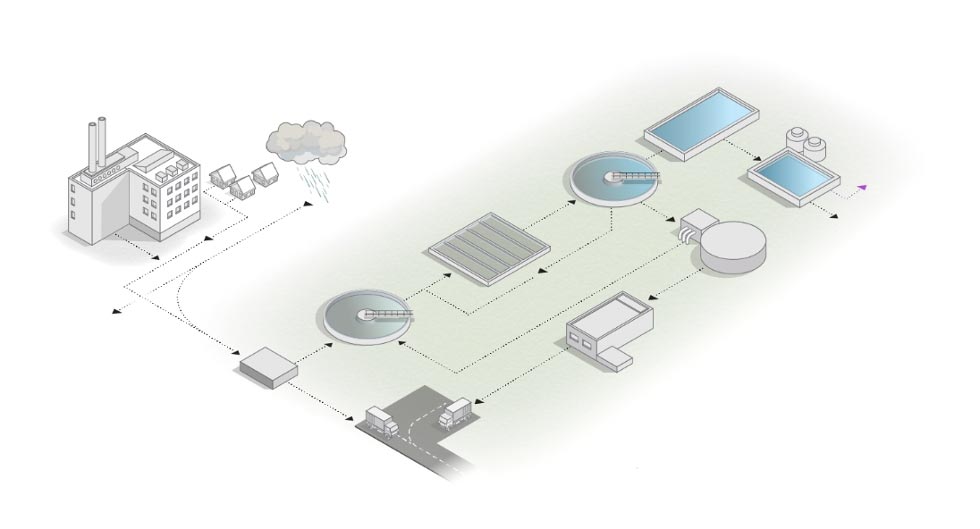
Collection Systems
Modern sanitary sewer collections systems move wastewater through a series of pipes from residential buildings, businesses, and industrial sites to wastewater treatment facilities for processing and discharge. Some older systems know as combined sewer systems also carry stormwater runoff in addition to the wastewater from residential and commercial sources.
The wastewater flows through underground sewer mains, most often by gravity, but sometimes assisted by pumps situated at lift stations. Depending on the topography of an area, these force mains vary in length up to a few miles long. Interceptors are locations where two lines meet and flow into a larger pipe, and can include large chambers accessible by manholes.
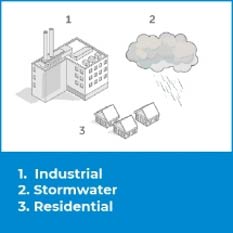
Flow Monitoring
Does your collection system experience excess flow during dry and wet weather? Have you confidently pin-pointed the source?
Do you ever experience sewer overflows?
Are you confident your collection system can handle additional flows from residential and commercial expansion?
Do you need to spot check or verify flow rates using a handheld instrument?
Hach offers solutions to your open channel flow monitoring needs.
Preliminary and Primary Treatment
Preliminary treatment is typically the first process within the treatment
During primary treatment, primary clarifiers allow organic solids to settle through gravity, while fats, oils
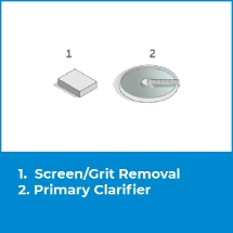
Process Step
Plant Inlet (Raw Influent)
Do you consistently monitor the relevant parameters in your influent to adjust your plant’s processes accordingly?
Do you have good transparency on the changes at your influent?
Hach offers solutions to your Primary Treatment needs. Explore the following solutions:
Parameters
Ammonia
Process: EZ3501 Ammonia Analyzer, EZ4005 Ammonia Analyzer
Lab: n/a
Conductivity
Process: n/a
Lab: HQ40D Portable Meter with CDC401 sensor
Dissolved Solids
Process: 3700 Inductive Sensors
Lab: HDQ Portable Meters
Flow
Process: Submerged AV Sensors
Lab: n/a
TOC, TP, TN
Process: BioTector B7000i Analyzer, UVAS plus sc Sensor
Lab: n/a
Multiple (TOC, P, TP, TN, TKN, COD)
Process: n/a
Lab: n/a
pH
Process: Digital Differential pH Sensors
Lab: HQ30D pH Meter with PCH101 Sensor
Suspended Solids
Process: TSS sc Sensors, Solitax sc Sensors,
Lab: TSS Portable, Gravimetric Test
Toxicity
Process: EZ1000 Toxicity Analyzers,
Lab: n/a
Process Controllers
Samplers
Claros Mobile Sensor Management enabled device
Sand Trap / Grit Chamber
Can you protect your treatment plant from industrial dischargers and monitor shock loads?
Hach offers solutions to challenges in your Sand Trap / Grit Chamber. Explore the following solutions:
Process Controllers
Claros Mobile Sensor Management enabled device
Influent to Primary Clarifier
Do you have clarity on your N, P and C levels for the next treatment steps?
Hach offers solutions to challenges in your influent to your Primary Clarifier. Explore the following solutions:
Parameters
COD
Process: EZ7000 Series COD Analyzers,
Lab:
Dissolved Solids
Process: 3700 sc Sensors
Lab: HQd pH Meter with CDC401 Sensor
Multiple (TOC, P TP, TN, TKN, COD)
Process: BioTector B7000iTOC Analyzer , UVAS plus sc Sensor
Lab: n/a
Orthophosphate
Process: Phosphax sc Phosphate Analyzer
Lab: n/a
pH
Process: pHD Sensors
Lab: HQD pH Meter with PCH101 Sensor
Suspended Solids
Process: TSS sc Sensors, Solitax sc Sensors,
Lab: TSS Portable, Gravimetric Test
Process Controllers
Claros Mobile Sensor Management enabled device
Primary Clarifier
Do you optimize your sludge Draw-Off (Sludge Removal) to your Biodigestor?
Can you accurately monitor your sludge levels?
Hach offers solutions to challenges in your Primary Clarifier. Explore the following solutions:
Process Controllers
Claros Mobile Sensor Management enabled device
Primary Treatment Effluent
Is your primary clarification operating adequately?
Are you providing optimal levels of N, P, and C for your secondary clarifier?
Are your pH and Alkalinity levels appropriate, not to damage the bacteria in your secondary treatment?
Hach offers solutions to challenges in your Primary Treatment Effluent. Explore the following solutions:
Parameters
Alkalinity
Process: EZ4000 Series Analyzers,
Lab AT10000 Alkalinity Instrument
Ammonium
Process: Amtax sc Analyzer, A-ISE sc Sensors, AN-ISE sc Sensors
Lab: n/a
BOD
Process: n/a
Lab: HQD pH Meter with LBOD Sensor,
COD
Process: EZ7000 Series Analyzers,
Lab: n/a
Conductivity
Process: 3700 Series Sensors
Lab: HQD pH Meter with CDC401 Sensor
pH
Process: phD sc Sensors
Lab: HQD pH Meter with PCH101 Sensor
SAC
Process: UVAS Plus sc Sensor,
Lab:
Suspended Solids
Process: TSS sc Sensors, Solitax sc Sensors,
Lab: TSS Portable, Gravimetric Test
Multiple (TOC, P, TP, TN, TKN, COD, Metals)
Process: BioTector B7000i Analyzer
Lab:
Orthophosphate
Process: Phosphax sc Phosphate Analyzer
Lab:
Oxygen Uptake Rate
Process: n/a
Lab: HQD Dissolved Oxygen Meter with LD sensor
Toxicity
Process: EZ7900 Analyzer
Lab: n/a
Volatile Acids
Process: EZ7200 Analyzer
Process Controllers
Samplers
Claros Mobile Sensor Management enabled device
Secondary treatment
Secondary treatment removes the soluble organic matter, nutrients such as nitrogen and phosphorus, and most of the suspended solids that escape primary treatment. Most often, biological processes are used in which microbes metabolize organic compounds and nutrients to grow and reproduce. The two most common biological secondary treatment processes are
For biological treatment to function efficiently, organisms require nutrients in a balanced ratio, including carbon, nitrogen, and phosphorus (referenced as C:N:P), as well as trace elements including iron, copper, zinc, nickel, manganese, potassium, sulfur, and other components which are typically present in wastewater. The commonly accepted C:N:P Ratio is 100:5:1, although some facilities thrive outside of this ratio, while others experience polysaccharide slime formation or filamentous bacteria growth that inhibit the biology and settling in the secondary clarifier.
Multiple biological processes can be employed to complete secondary treatment, including plug flow aeration basins, complete mix aeration tanks, sequencing batch reactors, oxidation ditches, trickling filters, moving bed biological reactors, integrated
Biological Nutrient Removal (BNR) alters the environment of the microorganisms to remove nitrogen and phosphorus from the water. A BNR process consists of anaerobic (no oxygen or nitrate), anoxic (no oxygen, nitrate is present), and aerobic (oxygen present) stages, during which the water is moved through a series of chambers to perform various biological functions.
Chemical treatment processes can also be used, such as the chemical removal of phosphorus. By introducing a chemical precipitant to within the aeration basin and clarifiers, phosphorus is removed by flocculation, binding into insoluble compounds that settle out and can be removed as sludge.
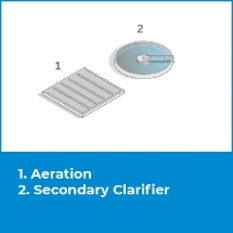
Application Specific Solutions
Nitrogen Removal:
Whether you are facing new regulations or trying to become more efficient, we can provide solutions for monitoring nitrate, dissolved oxygen, and other parameters that can save energy and chemical costs while optimizing nitrification and denitrification in your facility.
Learn more with Hach’s Nitrogen Removal Guide.Phosphorus Removal:
Whether you need a solution for chemical or energy savings, we can provide monitoring solutions that can save costs while optimizing your Phosphorus removal.
Learn more with Hach’s Phosphorus Removal Guide.Aeration Control:
If you are interested in lowering energy and maintenance costs, we have products with innovative luminescent technology to monitor dissolved oxygen and optimize your aeration control.
Learn more with Hach’s Aeration Control Guide.Dissolved Air Flotation (DAF) Optimization:
Does your facility
Process Step
Nitrogen Removal
Is your process for Carbon and Nitrogen removal optimized?
Do you control your Dissolved Oxygen levels manually, using a fixed set point, or based solely on flow rates?
Do you face significant electricity costs due to manual or fixed aeration controls?
Several technologies are used for Biological Nitrogen removal in wastewater treatment plants. From continuously-aerated treatment systems, to intermittent operated plants, sequencing batch reactors, and more, nitrogen elimination is often the central process in the wastewater treatment plants. While variations exist, this process usually requires real-time measurement of ammonium and nitrate for adjustment of DO concentration and optimization of nitrification and denitrification times. Hach offers solutions for your nitrogen removal needs. Explore the following solutions:
Parameters
Alkalinity
Process: EZ4000 Series Analyzers,
Lab AT1000 Alkalinity Intrusment
Ammonium
Process: Amtax sc Analyzer, A-ISE sc Sensors, AN-ISE sc Sensors
Lab: , HQD with Ammonia Sensor
COD
Process: EZ7000 Series Analyzers
Lab: n/a
Dissolved Oxygen
Process: LD02 sc Sensors
Nitrate
Process: EZ1000 Series Analyzers
Lab:
Nitrite
Process: EZ1000 Series Analyzers
Lab:
pH
Process: phD sc Sensors
Sludge Volume and Sludge Volume Index
Process: n/a
Lab: n/a
Suspended Solids
Process: TSS sc Sensors, Solitax sc Sensors,
Lab: TSS Portable, Gravimetric Test
Process Controllers
Samplers
Claros Mobile Sensor Management enabled device
Phosphorus Removal
Is your Phosphorous removal process optimized?
Do you control the chemical dosing manually, using a fixed dosing amount or based solely on flow rates?
Do you face significant chemical costs due to manual or fixed dosing of chemicals?
Chemical phosphorus removal is a critical step in wastewater treatment. It is usually done by adjusting chemical dosing of precipitants, based on phosphate concentration and flow, allowing for consistent effluent phosphorus values. Hach offers solutions for your Phosphorous removal needs. Our solutions range from complete optimization & control of the Phosphorous removal process with Claros Process Management to instruments that cater to the specific parameters you need.
Parameters
Orthophosphate
Process: Phosphax sc
Lab:
Sludge Volume and Sludge Volume Index
Process: n/a
Lab: Settlometer Kit
Process Controllers
Samplers
Claros Mobile Sensor Management enabled device
Secondary Clarifier
Do you optimize your sludge Draw-Off (Sludge Removal) to your Biodigestor?
Hach offers solutions for your clarification needs. Explore the following solutions:
Process Controllers
Claros Mobile Sensor Management enabled device
Tertiary Treatment
In tertiary treatment, techniques such as filtration, disinfection, carbon absorption, and other processes are used to remove the remaining organic load, suspended or dissolved solids, pathogens
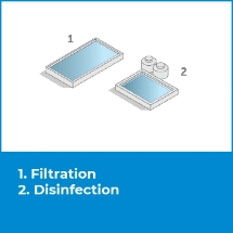
Process Step
Disinfection
Is your disinfection process working optimally?
Hach offers solutions to your disinfection needs. Explore the following solutions:
Parameters
UV Transmittance
Process: UVAS sc Sensor
Lab
Total Chlorine
Process: CL17
Lab
Monochloramine
Process: 5500sc Ammonia Monochloramine Analyzer
Lab: n/a
Process Controllers
Claros Mobile Sensor Management enabled device
Filtration
Are your filters working at maximum efficiency?
Hach offers solutions for your clarification needs. Explore the following solutions:
Process Controllers
Claros Mobile Sensor Management enabled device
Solids Handling
The method for handling the sludge removed from the process depends on the volume of solids as well as other site-specific conditions. Aerobic digestion is often used by facilities less than eight million gallons per day of inflow. Waste Activated Sludge and if present, Primary Sludge, are added to an aerated reactor where microorganisms feast on the organics and microorganisms present in the sludge to reduce the volatile solids content and the overall mass of sludge. Anaerobic digestion is typically used at facilities greater than eight million gallons per day of
Thickening involves concentrating the sludge by removing a percentage of the liquid portion by adding polymer
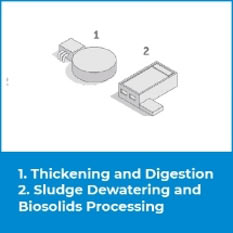
Applications
Sludge Thickening
Is your sludge thickened to an optimal level right now? How do you know?
How are you optimizing your sludge thickening system and chemical use?
How are you monitoring the impact of your thickener side stream?
Sludge thickening is a critical step for most biosolids management plans. It is the first step for reducing the sludge volume by removing free water. Sub-optimal sludge thickening has a large economic impact on the disposal costs. Solids carryover from centrate or filtrate can cause unnecessary pressure when returning the side stream to the beginning of the plant. Let us help you find the best solution for improving your visibility into your sludge thickening process.
Products
Total Suspended Solids
Process: Solitax sc Sensors
Portable: TSS Portable
Methods.Procedures: Gravimetric Testing
Process Controllers
Samplers
Claros Mobile Sensor Management enabled device
Biosolids Dewatering
Is your sludge dewatered to an optimal level right now? How do you know?
How are you optimizing your sludge dewatering system and chemical use?
How are you monitoring the impact of your dewatering side stream?
Sludge dewatering is a critical step for most biosolids management plans. It is typically the final step in water/solids separation for the reduction in sludge volume before disposal or drying. Sub-optimal sludge dewatering has a large economic impact on the disposal costs. Solids carryover from centrate or filtrate can cause unnecessary pressure when returning the side stream to the beginning of the plant. Let us help you find the best solution for improving your visibility into your sludge dewatering process.
Products
Total Suspended Solids
Process: Solitax sc Sensors
Portable: TSS Portable
Methods.Procedures: Gravimetric Testing
Process Controllers
Samplers
Claros Mobile Sensor Management enabled device
Sludge Digestion
Are your digesters operating at maximum efficiency?
How often do you monitor conditions of your digesters to ensure optimal performance?
Water resource recovery systems face the challenge of managing the biosolids generated as a part of the water recovery process. Digesters, both aerobic and anaerobic, are used to reduce the mass of biosolids and, in many cases, used to recover additional natural resources, such as biogas and nutrients. Whatever your specific needs are, let us help you find the best technology available.
Products
Alkalinity
Process: EZ Series Analyzers
Lab: AT1000 Titrator Instrument
pH
Process: pH Sensors
Lab: HQD Portable Meter with PHC101 Electrode
Volatile Fatty Acids
Process: EX Series Analyzers
Lab:
Dissolved Oxygen
Process: LDO2sc DO Probe
Lab: HQd Meter with LDO sensor
Ammonium
Process: Amtax sc Ammonium Analyzer
Process: A-ISE sc Ammonium Sensor
Lab:
Nitrate
Process: Nitratax sc UV Sensor
Process: N-ISE sc ISE Nitrate Sensors
Process: AN-ISE sc Sensors
Lab:
Hardness
Process: : EZ Series Analyzers
Process Controllers
Samplers
Claros Mobile Sensor Management enabled device
Water Intelligence
A growing field of expertise within the wastewater treatment industry, Water Intelligence Systems use digital technologies, advanced sensors, controllers, and algorithms to allow plant operators to increase efficiencies leading to overall cost savings in running the plant.
Claros™, the Water Intelligence System from Hach, integrates all plant data sources, including system data, device data, and manually-collected data, driving decisions to maximize efficiency and cost savings.
With these systems, data on flow rate, water composition, dissolved-oxygen, nutrient levels, and other factors are more easily tracked and verified. This leads to more responsive treatment options, automation capabilities, and data visualization and report generation.
Using data-driven insights into water quality, flow rate, and other factors, operators can reduce overtreatment (chemicals as well as aeration blower run time) while knowing their plant will remain within compliance limits.
As regulations become more stringent and plants need to find cost-savings, Water Intelligence Systems such as Claros will become more important and widely adopted. And with the Hach’s growing suite of Claros-Enabled sensors, controllers, devices, Process Management systems, and lab equipment, operators can configure a system that fits the unique requirements of any plant.
Interested in learning more? Visit hach.com/claros
Regulations
Regulations and permit limits vary from region to region and country to country. Generally, target limits are established by the acting authority, and plants measure and report to demonstrate compliance with established limits. In this way, important parameters that indicate water quality and environmental and health standards are monitored and maintained, ensuring the continued health and safety of the populations being served.
For information regarding regulations in the US: https://www.epa.gov/npdes
For information regarding regulations in the EU: https://www.eea.europa.eu/themes/water/water-management
For information regarding regulations in
Effluent & Reuse
While effluent from wastewater treatment facilities is commonly discharged to the environment in rivers, oceans, or other bodies of water, there are a variety of other options for discharge. These include agricultural irrigation; use in parks and recreational facilities (golf courses and sports field irrigation,
Applications
Flow Monitoring
How are you monitoring your effluent flow?
Are you confident in the measurements?
Do you need to verify your effluent flow with a handheld instrument?
Hach offers solutions to your open channel flow monitoring needs. Explore our solutions
Phosphorus
Do you wish you had a better handle on your phosphorus removal?
How do you monitor the phosphorus in your effluent? Do you trust the results?
The demand to meet effluent phosphorus requirements is growing for water resource recovery and reuse facilities. Continuous online analyzers or EPA equivalent laboratory tests help ensure you have maximum visibility of your system performance and will help prevent costly or embarrassing upsets and violations. Here you can find many flexible solutions that span the range for quick spot testing to continuous online monitoring to EPA approved methods for both orthophosphate and total phosphorus.
Products
Claros Mobile Sensor Management enabled device
Nitrogen
Are you confident you are meeting your effluent nutrient targets right now?
Are you facing a challenging Ammonia or Total Nitrogen regulation?
The demand to meet effluent Total Nitrogen, Ammonia, and/or nitrate requirements is growing for water resource recovery and reuse facilities. Continuous online analyzers or EPA equivalent laboratory tests help ensure you have maximum visibility of your system performance and will help prevent costly or embarrassing upsets and violations. Here you can find robust laboratory and real-time monitoring solutions for nitrogen in all its relevant forms.
Products
Spectrophotometers
Nitrate Sensors
Ammonium Analyzers
Total Nitrogen Analyzers
US EPA Compliant Lab Methods
Ammonium as Nitrogen
Ultra-Low Range
Low Range
High Range
Ultra-High Range
Nitrate as Nitrogen
Nitrite as Nitrogen
Total Nitrogen
Claros Mobile Sensor Management enabled device
Organics (BOD, TOC, COD)
Are you confident you are meeting your effluent BOD permit right now?
All water resource recovery facilities are required to reduce the number of organics in their effluent. Whether the goal is regulatory compliance reporting or real-time monitoring of a particularly critical treatment process, we have flexible solutions worth exploring.
Products
Lab/Portable Meters
Spectrophotometers
TOC Analyzers
BioTector B7000i Analyzer
EZ Series Analyzers
Organics Load
Claros Mobile Sensor Management enabled device
Solids/Turbidity
Are you confident you are meeting your effluent turbidity or solids targets right now?
Does your reuse application require accurate and consistent turbidity monitoring?
All water resource recovery facilities are required to reduce the amount of total suspended solids in their effluent. Many facilities also doing beneficial reuse of their effluent stream are also required to monitor turbidity. Whether the goal is regulatory compliance reporting or real-time monitoring of a particularly critical treatment process, we have flexible solutions worth exploring.
Products
US EPA Compliant Lab Methods
Solids
Dissolved Solids
Filterable Solids
Settleable Solids
Total Solids
Total, Non-Filerable Solids
Volatile, Non-Filerable Solids
Turbidity
Method 8195
Mitchell Turbidity Method
Claros Mobile Sensor Management enabled device
Oil and Grease
Has your process removed enough oil and grease to comply with regulations or downstream reuse requirements?
Water resource recovery facilities face the challenge of reducing fats, oils, and greases prior to discharge or sensitive downstream reuse applications. Whether you are looking for quick laboratory methods or online monitoring solutions to help gain visibility to a critical process, let us help you find the best solution.
Products
UV Flourescence Probe
Claros Mobile Sensor Management enabled device
pH
Are you confident you are meeting your effluent pH target right now?
How do you monitor your effluent pH? Are you confident in the measurement?
Accurate effluent pH is required to protect the downstream needs, whether it is discharging into the environment or being captured for beneficial reuse. Ensuring the best data is being used for your needs requires the best equipment. Let us help you find the best solution for your pH measurement needs.
Products
US EPA Compliant Lab Methods
Claros Mobile Sensor Management enabled device
Dissolved Oxygen
Are you confident you are meeting your effluent Dissolved Oxygen target right now?
How do you monitor your effluent Dissolved Oxygen? Are you confident in the measurement?
Accurate effluent Dissolved Oxygen is required to protect the downstream needs, whether it is discharging into the environment or being captured for beneficial reuse. Ensuring the best data is being used for your needs requires the best equipment. Let us help you find the best solution for your DO measurement needs.
Products
Claros Mobile Sensor Management enabled device
Disinfection
Are you confident you are meeting your effluent disinfection requirements right now?
Does your reuse application require consistent disinfection? How do you ensure compliance?
Water resource recovery facilities often face disinfection requirements for their effluent and reuse streams. Whether your site is using UV irradiation, Chlorine oxidation (in any form), or something else, Hach has a flexible suite of laboratory and online monitoring solutions. Let us help you find the best solution for your disinfection goals.
Products
Spectrophotometers
Automatic Titrators
Online Chlorine Analyzers
LC10sc Chlorine Analyzer
CL10 sc Amperometric Chlorine Analyzer
Digital UV Probes
Claros Mobile Sensor Management enabled device
Microbiology
Does your effluent contain the right microbiology?
Effluent microbial counts are key parameters that help ensure water discharging from Water resource recovery facilities is safe for our environment and ourselves. Let us help you find the best solution for your specific goals.
Products
Microbiological Testing
Samplers
Claros Mobile Sensor Management enabled device




